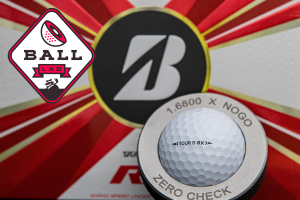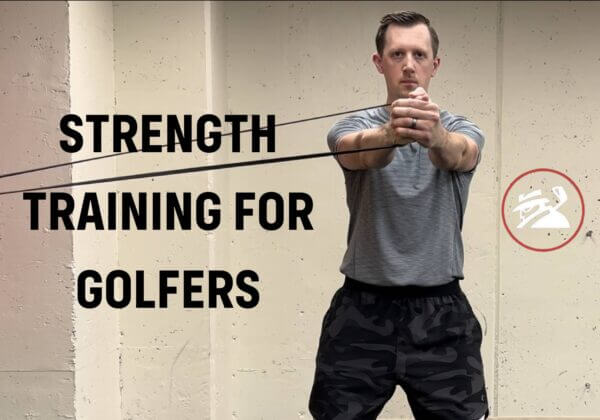MyGolfSpy Ball Lab is where we quantify the quality and consistency of the golf balls on the market to help you find the best ball for your money. Today, we’re taking a look at the 2022 Bridgestone Tour B RX. To learn more about our test process, how we define “bad” balls, check out our About MyGolfSpy Ball Lab page.
About the Bridgestone Tour B RX
While the TOUR B RX doesn’t get any love on the PGA TOUR, it has been Lexi Thompson’s ball of choice of late. Made famous by Matt Kuchar’s dad, Bridgestone classifies the TOUR B RX as for golfers with speeds below 105.
It’s no secret that we’re not fans of compression-based ball fitting but what you should take from that is that the RX trends to the soft side and with that comes a bit higher flight and lower spin than the “over 105” offerings.
Bridgestone Tour B RX Construction
Like everything else in the Bridgestone TOUR B lineup, the RX has three-piece construction. It offers a 338-dimple injection-molded urethane cover with REACTIV IQ technology. The Bridgestone TOUR B RX is produced at the company’s factory in Covington, Ga.
Compression
On our gauge, the 2022 Bridgestone TOUR B RX has an average compression of 79. That’s six points firmer than the previous model and puts it alongside balls like the OnCore Vero X1, Srixon Z-Star and Titleist Velocity (two-piece ionomer).
Across the market as a whole, it qualifies as a “medium feel” golf ball, though it’s definitely on the softer side among balls with urethane covers.
Diameter and Weight
I don’t recall any issues with Bridgestone balls as they relate to USGA regulations. As a rule, the company doesn’t flirt with the size limit the way some of its competitors do (Bridgestone TOUR B balls run slightly larger than other Tour offerings) and, save a single ball in our 2022 TOUR B XS sample, weight isn’t an issue, either.
In the case of the RX, all of the sample adhered to USGA rules for both weight and diameter.
Inspection
Centeredness and Concentricity
For the most part, Bridgestone does a good job with layer concentricity. I won’t say we never find any issues but they are few and far between.
In the case of the TOUR B RX, we found a single ball with a concentricity issue sufficient enough for us to flag the ball as bad.
Core Consistency
Core consistency and color were consistent throughout the sample. We found nothing of concern.
Cover
While we didn’t find anything significant enough to flag as bad, we noted that some balls had more of a texture to the cover than others. We also found a couple of balls (isolated to Box 2) where dimples at the poles were slightly raised.
Finally, we also noted a couple of balls where there were minor imperfections/indentations where the two halves of the cover come together.
While notable, nothing was so significant that we flagged any balls as bad.
Bridgestone TOUR B RX – Consistency
In this section, we detail the consistency of the 2022 Bridgestone TOUR B RX. Our consistency metrics provide a measure of how similar the balls in our sample were to one another relative to all of the models we’ve tested to date.
Weight Consistency
- Weight consistency for the Tour B RX falls within the average range.
- Box 3 was a tick heavier overall but not significantly.
- In terms of the market as a whole, we would consider the Bridgestone TOUR B RX to be of average weight.
Diameter Consistency
- Diameter consistency for the 2022 Bridgestone TOUR B RX falls within the Average range.
- The size of the balls falls within the Average range relative to the market as a whole.
Compression Consistency
- Compression consistency falls within the Poor range and is a significant reason for the below-average overall score.
- In many respects, it mirrors what we found when we tested the 2022 Bridgestone TOUR B XS.
- The spread of compression was similar across all three boxes but two balls (one in Box 1 and one in Box 2) were flagged for having compression values significantly lower than the sample median.
- The compression delta across the entire sample was 20 points. For the sake of comparison, that’s more of a spread than we’d expect to find between the TOUR B RX and a TOUR B X.
True Price
True Price is how we quantify the quality of a golf ball. It's a projection of what you'd have to spend to ensure you get 12 good balls.
The True Price will always be equal to or greater than the retail price. The greater the difference between the retail price and the True Price, the more you should be concerned about the quality of the ball.
Bridgestone TOUR B RX – Summary
To learn more about our test process, how we define “bad” balls and our True Price metric, check out our About MyGolfSpy Ball Lab page.
As we mentioned, the results largely mirror what we found when we tested the 2022 TOUR B XS. Significant defects were few, diameter and weight consistency were average, but compression across the sample was wildly inconsistent.
The Good
- Average diameter and weight consistency
- Only one bad ball not related to compression issues
The Bad
- Significantly inconsistent compression across the sample.
At the time of review, the 2022 Bridgestone TOUR B RX gets an overall grade of 59.





















Parsong
9 months ago
Thanks for the review. Someone needs to get Tiger up to speed and tell him what an awful ball he is using. I probably need to pay better attention also since I have started playing them and love them. However, they have not lowered my single digit hdcp yet.